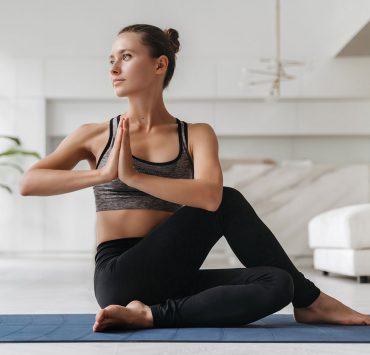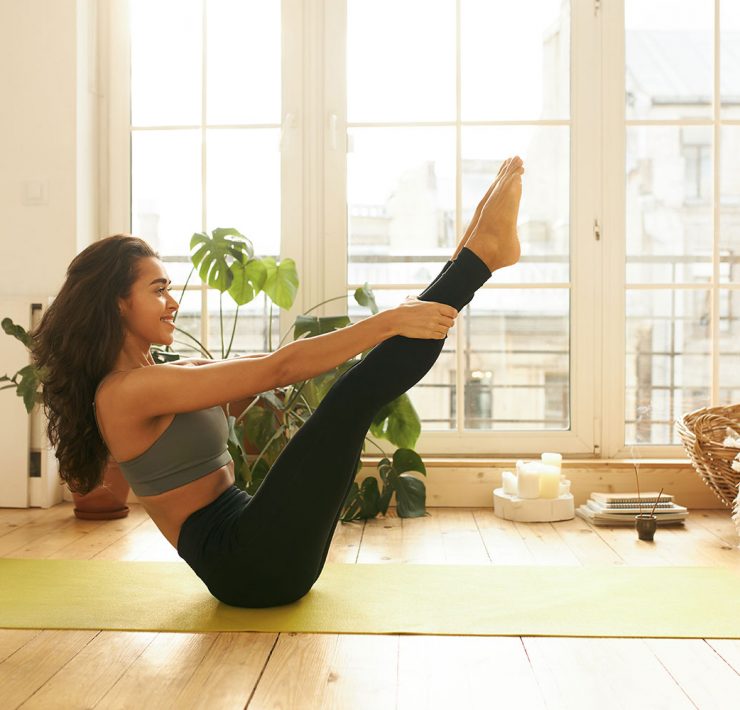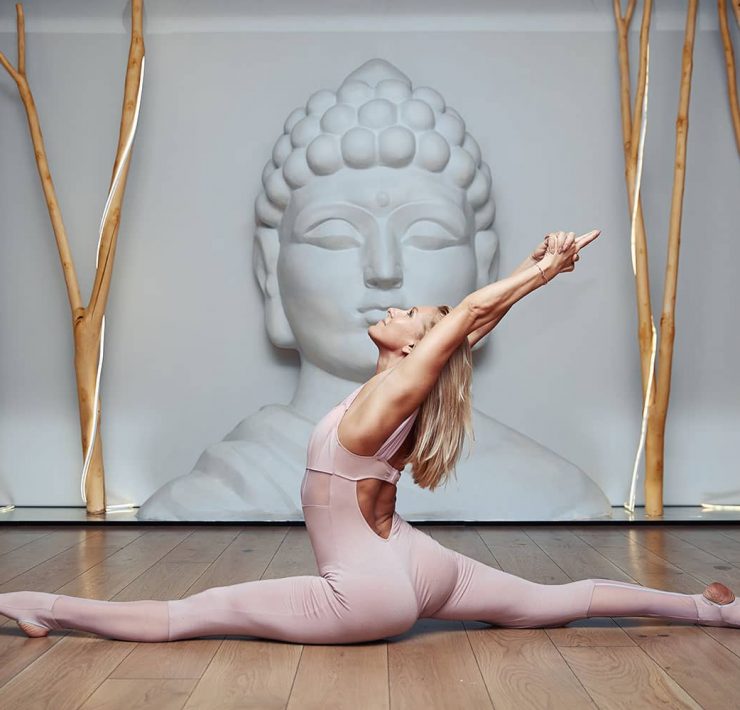
As a former social media manager and marketing guru, Amy…
You may be familiar with the Dragon poses. It seems that many yoga practitioners either love them or hate them, but they usually only hate them in that “actually feels really good but in a painful way” way. You may find that you are having to force yourself to do this pose, but being thankful when you actually do it as it really feels good especially in today’s society with lots of sitting and sedentary activities.
What are the Dragon Poses?

Ever found yourself having hip pain or feel a tightness in your hips? Let’s face out, most of us have tight hips. Luckily for us though, Yin Yoga poses are an excellent way to help release the connective tissues in the hips.
Dragon Poses are yin yoga poses that aid in deeply opening the hips and groin area and also help in targeting the hip flexors and quads. The hip joints are a type of synovial joint known as a ball-and-socket. Hip joints connect the head of the femur (or thigh) bone to the acetabulum of the pelvis or hip socket. The hip joints are built for stability and the femur sits deeply in the socket and is designed for weight bearing. Mobility and flexibility of the tissues around the hip joint is not always guaranteed due to this stability.
As you likely know, there are many different styles of yoga. Some are fast-paced and rhythmic such as Vinyasa or Ashtanga while others are much, much slower and can even feel static especially after the former examples. One such example is Yin Yoga. In Yin Yoga, poses are often held in stillness for anywhere from 1 to 5 minutes depending on the specific pose’s intensity.
Aside from the movement speed, the second major difference of Yin Yoga from some of the more common physical yoga practices is that there is little to no muscular involvement. Based on Traditional Chinese Medicine, the target area in the poses is the connective tissues and the energetic meridians of the body.
Yin yoga is a meditative practice that helps one quiet their body and thus quiet their mind. It is the practice of observing your body without judgement and accepting it exactly how it is. It is a slow, gentle practice consisting of opening and releasing without striving, pushing, and most importantly, without effort.
Within Yin Yoga, we disengage the muscles so that we can work deeper into the “yin” tissues of the joints, tendons, ligaments, and the muscles.
With that being said, you’re probably wondering – is it Dragon pose (singular) or Dragon poses (plural)? You may find yourself slightly confused. Dragon pose has many different variations – eight to be specific. They each have their own benefits, but overall, they all help improve the health of the hip flexors and to relieve tension from the quadriceps.
Dragon Pose is considered a beginner level yoga pose that is performed in a prone position.
When Do You Use Dragon Poses?

The Dragon Pose is often used to open up the hips. Our mental health and emotions directly affect our physical health and our bodies. As we store a lot of emotions in our body, your body reacts to these emotions, whether in a positive way or a negative way. Yin yoga poses (which the Dragon Pose is one of) stimulate the meridian lines which run through the body’s major organs. Different emotions are stored in different places throughout the body and when we work through the layers of the body, we work also through these layers of our emotions.
Our hips, believe it or not, carry a big portion of these stored emotions. This is why hip opening poses can be very challenging but can also be very releasing and satisfying at the same time. By being consistent in your practice, you will naturally loosen tight hips which will make you even more confident in completely hip-opening poses.
Dragon Poses are really great poses for many athletes to do including runners and bikers.
Additionally, this is a great pose to do before bedtime, when traveling, and to ease lower back pain.
The Benefits of the Dragon Poses

Generally, the Dragon Poses have many amazing benefits both for the physical and mental aspects of your body. These poses succeed in doing a number of different things for you including benefits that affect you mechanically, energetically, and emotionally.
Mechanically, the Dragon Poses are deep hip openers and target the hip flexors from the back leg. In terms of physical benefits, this pose also helps ease the pain of sciatica, increasing hip mobility and stretching out the quadriceps.
Energetically, the Dragon Poses also do an amazing job of stimulating the liver, spleen, kidney, stomach, and gallbladder channels related to the earth element.
Additionally, in terms of the mind and emotions, the Dragon Poses has many benefits including enhancing endurance and balance.
A Few Tips to Consider Before Practicing Yin Yoga

There are a few things to consider before doing Dragon Poses or practicing Yin Yoga in general.
- The goal of Yin Yoga is not to stretch beyond your range of motion. As yoga practitioners, it is of the utmost important to listen to cues from your body when finding the balance between effort and ease.
- Do not be ashamed to use yoga props to support your body through your practice. Props are vital to aid the body in softening and easing into Yin Yoga poses and to settle into the stillness that comes with them. Suggested props include two yoga blocks or 1-2 yoga blankets.
- If you already have flexible tendencies, back out of the poses to work on strengthening your connective tissue.
- The effects of a Yin Yoga practice can last for several days as your bodies’ connective tissues adapt and stretch. Make sure to note how you feel after your practice as well as the days following your practice. And, always remember to keep yourself hydrated and nourish your body well. Similar to a massage, Yin Yoga allows for a deep release of toxins and holding patterns in the body.
Dragon Pose: Step-by-Step Instructions to Follow
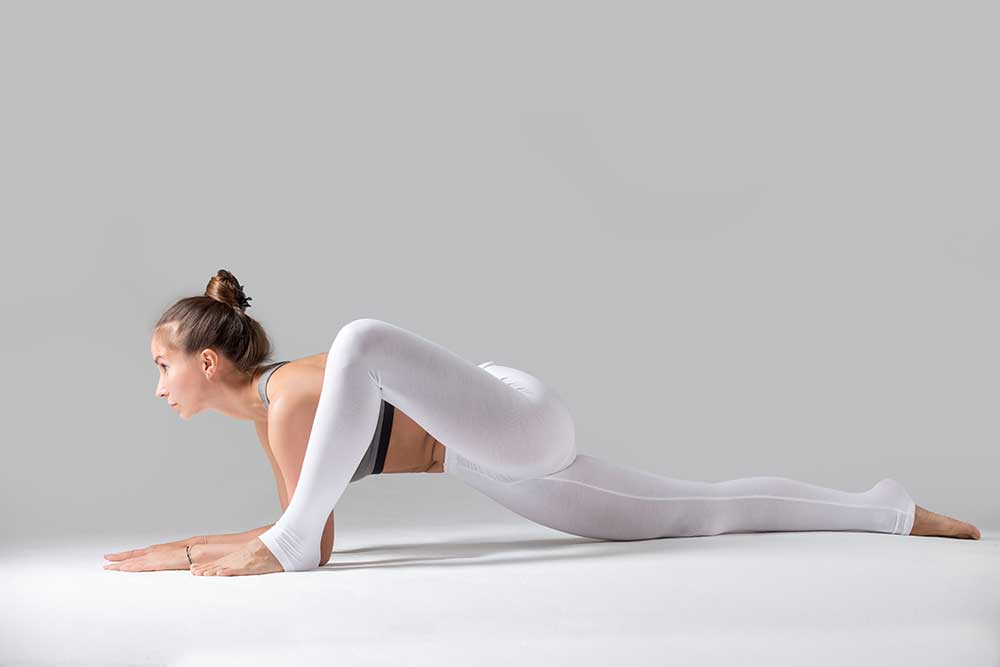
The following step-by-step instructions are for the general Dragon pose also known as Baby Dragon Pose. For the other seven variations, see below these instructions.
Step 1
Starting from a table top position (on all fours), step your right foot in between your hands with your right knee just above the heel. Your hands can be either on the floor or on your right thigh. For a deeper stretch, you can place your hands inside your right foot and lower your elbows onto a block or onto the ground.
Step 2
Continue by lowering your left knee to the floor, sliding the leg back until you feel a nice (not painful) stretch in the left hip and thigh. Ensure that you’re not resting directly on the top of the kneecap but just slightly beyond it while gently pressing your front foot into the floor. Keep your hands on either side of your front foot or on blocks if needed. Continue by holding the pose for 3 to 5 minutes.
Step 3
To come out of the pose, move the back knee forward and tuck your toes while at the same time ground your hands on either side of your right foot and step back into a table top position.
Step 4
Repeat the same steps on the other side.
Dragon Pose Variations
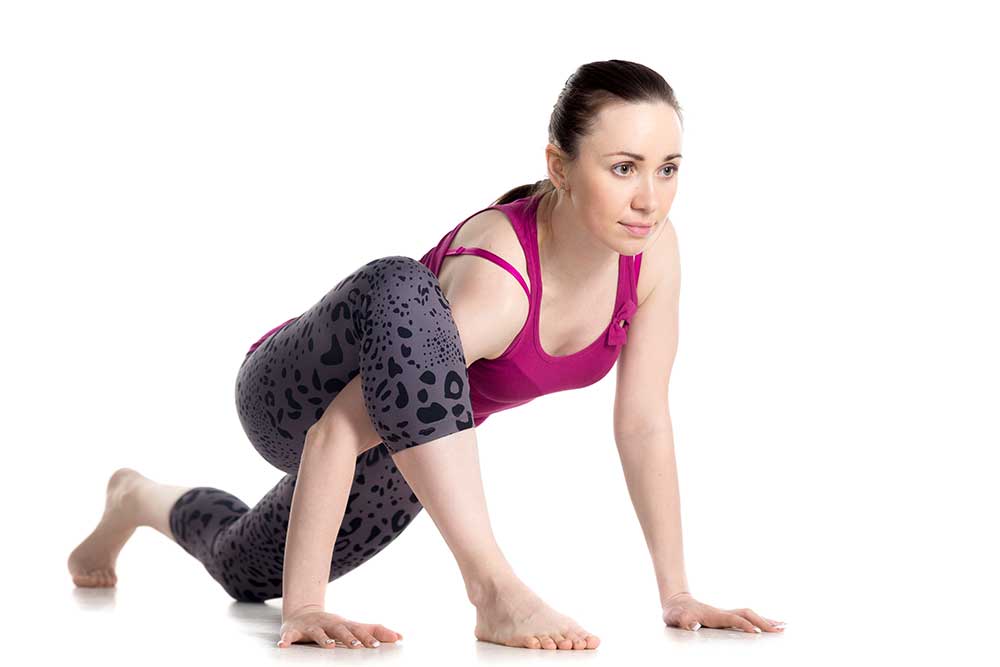
As mentioned previously, there are a whopping eight variations of the Dragon pose: Baby Dragon, Dragon Flying High, Dragon Flying Low, Twisted Dragon, Winged Dragon, Overstepping Dragon, Dragon Splits, and Fire-Breathing Dragon.
Baby Dragon
The above step-by-step directions are for the general Dragon Pose which is also referred to as “Baby Dragon” by many.
Dragon Flying High
To achieve this Dragon pose variation, place your hands on your top thigh and lift your chest. This increases the weight over your hips and offers a mild backbend. Allow your weight to sink further into your hips for a deeper stretch on this Dragon pose variation.
Dragon Flying Low
For this more intense variation of Dragon Flying High, place your hands inside the front foot and walk your hands forward. You can also place your elbows down on the mat or onto blocks. Additionally, you can walk your arms away and rest on your forearms for the deepest version of this Dragon pose variation.
Twisted Dragon
For the Twisted Dragon variation, you will achieve this by firmly flexing your front foot and gently pressing your front knee outward with your hand, rotating your chest up and towards the bent knee.
Winged Dragon
To move into the Winged Dragon variation, keep your forearms on the inside of your right leg and then start to wing the right knee out a few times until you are comfortably resting on the outside edge of that food. Walk your hands forward or rest your elbows down on the mat or yoga blocks if needed.
Overstepping Dragon
For the Overstepping Dragon variation, allow your front knee to come forward until the heel of your foot is just about to lift off the ground. Keep the majority of your weight in your hands, on either side of your front foot. This Dragon pose variation is a nice simulation in the Achilles tendon.
Dragon Splits
For the most advanced Dragon pose variation, you’ll want to move into the Dragon Splits pose. To do this, straighten both of your legs into a splits position by walking your back leg further down the mat to bring both legs straight. Supporting your front leg with a bolster or other prop allows the muscles to relax for a better experience in this variation. Keep your torso up or fold it over your front leg to find different and/or more comfortable sensations.
Fire-Breathing Dragon
Aside from the coolest Dragon pose name, Fire-Breathing Dragon is the final Dragon pose variation. This particular variation can be performed during any of the former Dragon pose variations by simply tucking the toes of the back foot and lifting the resting knee.
Modifications & Variations for Dragon Poses
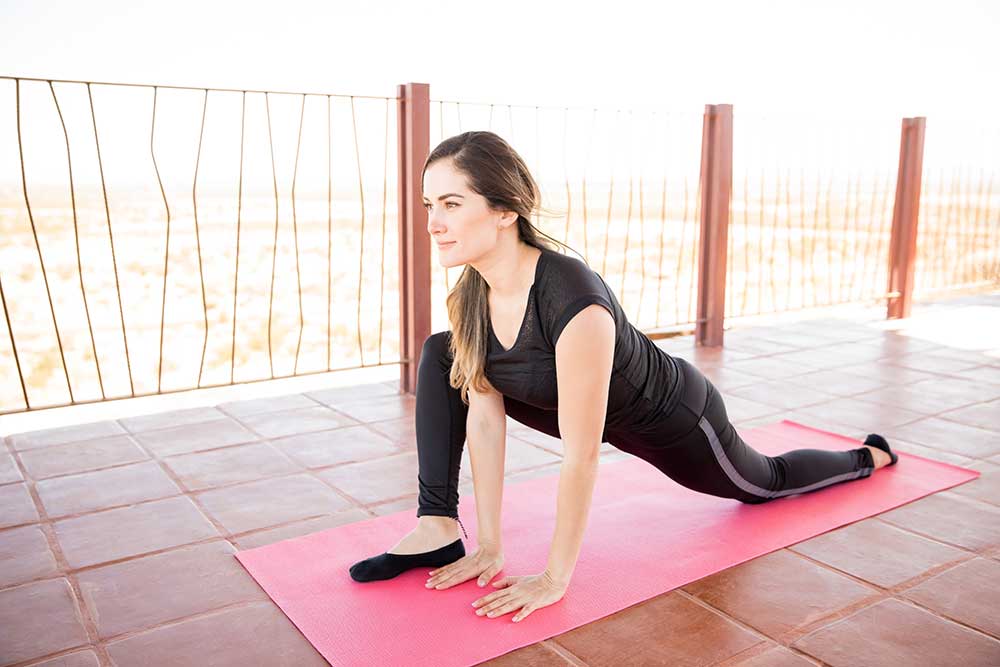
First things first, do not practice Dragon Pose or any of its variations if you are injured, sick, or you feel pain at any time during your practice or class.
If you’re having trouble with your balance, you can place two blocks on the side of your body. This can also help you to go deeper into the pose as well.
Specific Dragon Pose Modifications for Weak Knees
If you have knee problems or weak knees, pad your back knee and pay special attention to the sensation in the front knee. Avoid the ‘Overstepping Dragon’ variation if you have knee complications.
Specific Dragon Pose Modifications for Weak Lower Back
If you have lower back complications or a weak lower back, make sure to be mindful while lifting your chest as you will move into a backbend or choose a low variation.
Specific Dragon Pose Modifications for the Beginners
If you’re a beginner to yoga or the Dragon Pose specifically, there are a few modifications you can do to help ease you into Dragon Pose.
- Since the sensations in this pose can get rather intense, start out by holding the pose for 1 to 3 minutes.
- Place a block vertically under the front thigh or hip for support as this will allow you to relax more deeply into the pose.
- Place a blanket under your back knee in the case of any discomfort.
Alternative & Counter Poses for Dragon Poses

A few alternative poses for Dragon pose can be the Saddle Pose or Swan Pose. Both of these can be used to target the hip flexors and offer a backbend. In case you’re wanting some similar benefits, these would work as well.
If you’re looking for a few counter poses for Dragon pose you can perform Downward-Facing Dog Pose followed by Child’s Pose.
What's Your Reaction?
As a former social media manager and marketing guru, Amy is up to date on the hottest trends. Using her prior experience, she flawlessly delivers relevant and accurate information on a wide range of topics.






